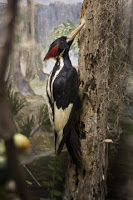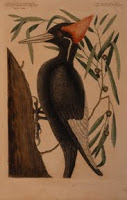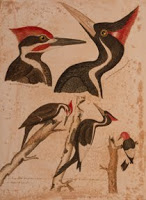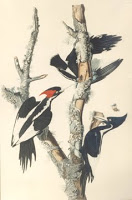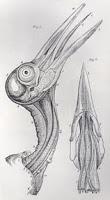Ivory-Billed Woodpecker
Charleston is busy ramping up for the season with the opening of the Southeastern Wildlife Expo. With The Charleston Museum’s vast natural history collection, we thought it would be fun to focus on several interesting items in our collections throughout the coming week.
We were recently contacted by a producer looking for specimens in museum collections for a documentary about Ivory-billed Woodpeckers. This bird has been in the news a lot over the past few years with reported sightings of this extirpated beauty and the subsequent searches by such groups as the Cornell Lab of Ornithology. So, this got me searching for Ivory-bill-related objects in our own collection.
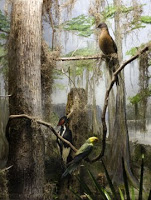 Well, I didn’t have to look very far. We have a lovely specimen on exhibit in the Mark Catesby section of our Natural History hall. It is housed in a diorama with two other extinct birds, the Carolina Parakeet and the Passenger Pigeon. The Ivory-billed Woodpecker (Campephilus principalis) was once widespread in South Carolina, especially in hardwood bottomlands, such as those in the Santee River Swamp. The Ivory-bill’s demise was caused mainly by hunting, but also by the destruction of its habitat (logging). By 1936, it had disappeared from South Carolina.
Well, I didn’t have to look very far. We have a lovely specimen on exhibit in the Mark Catesby section of our Natural History hall. It is housed in a diorama with two other extinct birds, the Carolina Parakeet and the Passenger Pigeon. The Ivory-billed Woodpecker (Campephilus principalis) was once widespread in South Carolina, especially in hardwood bottomlands, such as those in the Santee River Swamp. The Ivory-bill’s demise was caused mainly by hunting, but also by the destruction of its habitat (logging). By 1936, it had disappeared from South Carolina.
Next the “hunt” for the Ivory-billed Woodpecker led me to the Museum’s archives. Our archivist is always up for a new quest, so she rounded up the Ivory-billed-related objects within her collection. There was more than I had expected!
Mark Catesby (1679-1749) was the first to describe the Ivory-billed Woodpecker. The Museum’s first edition copy (one of only approximately 80 remaining copies) of Catesby’s Natural History of Carolina, Florida and The Bahama Islands includes this 1731 plate of an Ivory-bill. The folio is currently on exhibit and a reproduction of this specific plate resides near the Ivory-bill.
Alexander Wilson (1766-1813) also illustrated the species in his American Ornithology. While this rare 1808 volume resides in our archives, a reproduction of the Ivory-bill plate is on exhibit with the specimen.


